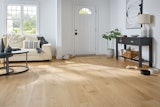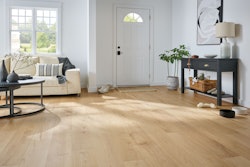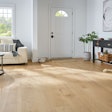For wood flooring retailers looking to enjoy a profitable 2017, the economic stars are shifting into happy alignment. Consumers are expected to have more spendable money in 2017, thanks to anticipated increases in employment and wages. And major drivers of the economy—such as business investment and housing construction—are expected to continue their modest growth.
Higher sales
The improved economy should fuel more sales for retailers. Core retail sales are expected to increase by 5.4 percent, up from the mediocre 4.2 percent increase expected for 2016 when figures are finally tallied, according to Scott Hoyt, senior director of consumer economics for Moody’s Analytics, a research firm based in West Chester, Pa. (Core retail sales exclude volatile revenues from auto sales and gas stations.)
Retail results for 2016 were on the weak side of historic norms and were pretty much flat with 2015. Hoyt attributes the disappointing performance to deflationary pressures.
The deflation-adjusted increase for 2017 is expected to compare favorably with periods of healthy retail activity, such as the decade of the 1990s and the years just prior to the Great Recession, Hoyt said.
The fortunes of retailers depend largely on a growing overall economy. For 2017, Moody’s expects GDP to grow 2.9 percent. That’s a healthy increase from the 1.6 percent growth expected when 2016 numbers are finally tallied, and the 2.6 percent growth of 2015. (The American economy’s average historic growth rate over the years is 2.5 percent.)
Strong labor
From a retailer’s point of view, perhaps the most important economic factor is the labor market, where increases in employment and wages are expected to fill consumers’ pockets with spendable cash.
That expansion is expected to continue, with unemployment expected to decrease to about 4.6 percent by the end of 2017, down from the 4.9 percent recorded in late 2016.
The nation is finally starting to see signs of wage acceleration. Average hourly earnings are expected to grow by three percent in 2017, up from the 2.6 percent increase of 2016, which was itself a healthy rise from the 2.3 percent growth of the previous year.
Tight housing
Housing, another economic sector that helps drive retail sales, is expected to continue to do so in 2017, although there is a moderating trend. Moody’s forecasts a 3.5 percent increase in housing starts in 2017, a de-escalation from the 9.7 percent of 2016, a pace which was itself slower than the previous year’s rate of 10.7 percent.
The de-escalation is caused not by a decline in demand but by limitations of supply, said Kathryn Asher, associate economist in the research division of Moody’s Analytics.
Confident nation
The healthy employment and housing sectors contribute to generally positive feelings at large. That’s good for retailers, because confident consumers tend to be aggressive shoppers. And when they want to open their wallets wider, banks are cooperating.
“An ongoing support for retailers is the increased availability of credit,” Hoyt said. “We are seeing an acceleration of credit card balance growth, and that that is a positive sign.”
Tight margins
Manufacturers, in particular, are looking toward 2017 more favorably after coming off a fairly modest year. “Our members are starting to see an increase in sales and are in the process of building inventories,” said Tom Palisin, executive director of The Manufacturers' Association, a York, Pa.-based regional employers' organization with more than 370 member companies.
Margins for larger employers will continue to compress as the tighter job market puts upward pressure on wages. Poor productivity may also continue to pressure margins over the coming 12 months. “Corporate profit growth will remain modest in 2017 as we look for a 1.4 percent gain,” Asher said.
Retail challenges
While a good year is expected for retailers, they must also address the challenges of rising labor costs and moderation in the number of consumer shopping trips, both of which put pressure on retailer margins. What to do?
Retailers should become more focused on smart hiring and training, and pay attention to improving staff effectiveness, said Doug Fleener, president of Sixth Star Consulting, Lexington, Mass.
Pricing pressure
As retailers move into the early months of 2017, economists suggest keeping a watchful eye on deflation—that surprise player that so dramatically affected retail results in 2016.
Deflation has been caused by low energy prices affecting transportation costs and the strength of the dollar, Hoyt said. Retailers, therefore, should keep a careful eye on their power to control pricing as the year gets underway. The good news is that deflation is expected to experience an adjustment of its own.
Better execution
As the above comments suggest, 2017 will bring opportunity and challenge. The successful retailer will keep a watchful eye on the highlighted threats to profit, while taking a new look at the primary means of exploiting change: quality operations.
“Get better at executing what you have learned,” Fleener said. “And that goes from the owner on down to the front-line employee. In almost every company there is a gap between the things we say we are going to do and what we actually do. In that gap there is incredible opportunity.”























